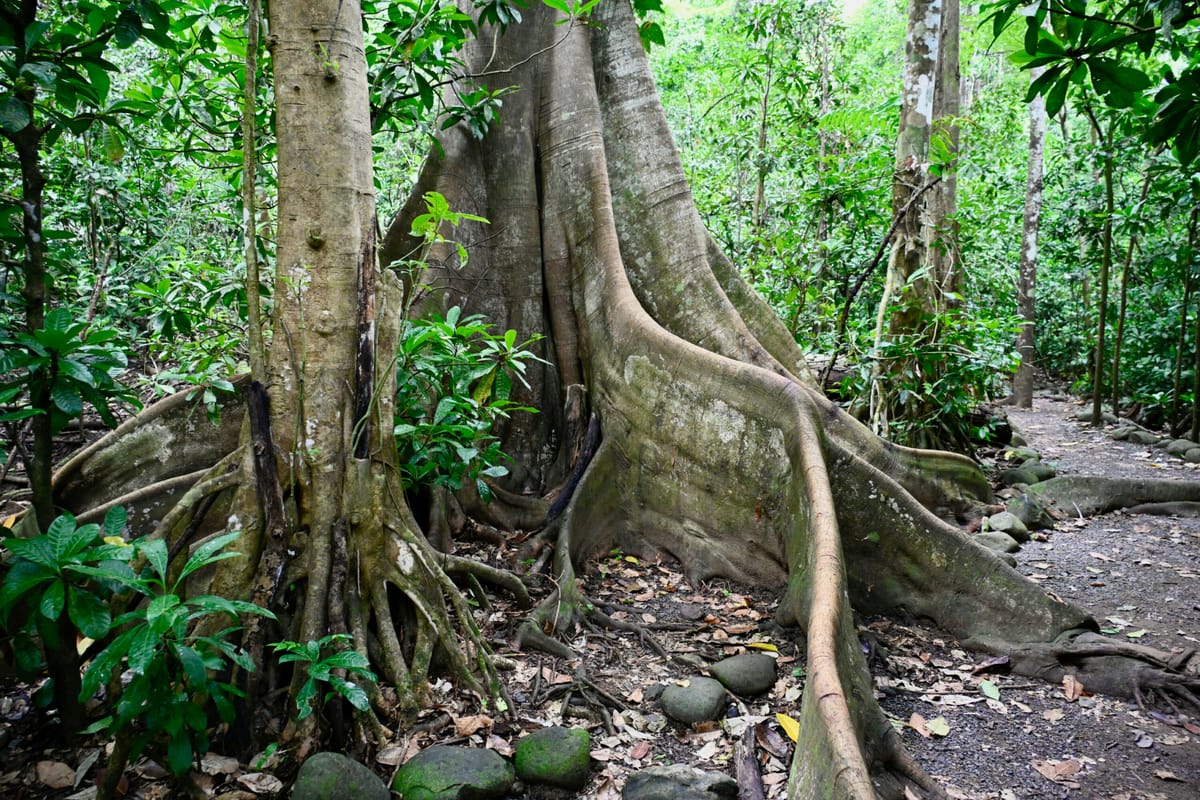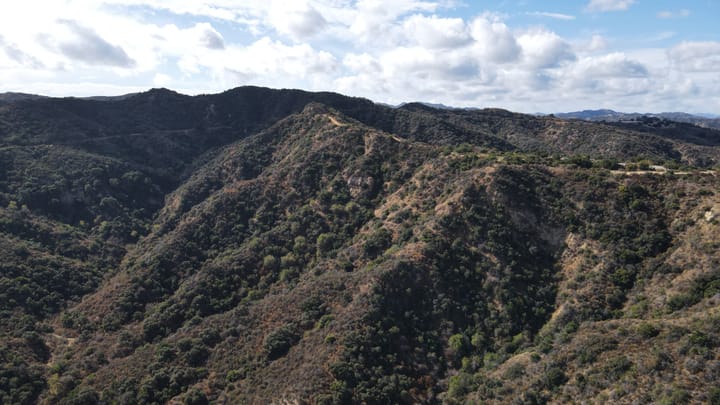The Enigmatic Strangler Fig of Carara National Park: A Comprehensive Exploration
Dive into the life cycle and ecological impact of the strangler fig in Carara National Park, a vital species in the rainforest ecosystem that shapes biodiversity and inspires conservation.

Introduction: Unveiling the Strangler Fig
Carara National Park, a treasure trove of biodiversity located in Costa Rica, is home to one of the most intriguing and architecturally complex trees in the tropical rainforest ecosystem—the strangler fig. Known locally as 'matapalo', which translates to 'killer tree', this species plays a pivotal role in the ecological dynamics of the forest. The strangler fig is a fascinating study in survival, adaptation, and ecological significance, embodying the delicate balance between life and death in its quest for sunlight and space.
The Strangler Fig's Lifecycle: A Tale of Triumph
- Epiphytic Beginnings: The journey of a strangler fig starts when its seeds, typically dispersed by birds, germinate in the crevices of a host tree. These seeds sprout high above the ground, enjoying an unobstructed view of the forest canopy.
- Ascension to Dominance: As the seedling grows, it sends roots down to the forest floor, enveloping the host tree in a tight embrace. Over time, these roots thicken and merge, forming a living lattice that gradually strangles the host.
- Architectural Marvel: The host tree eventually dies and decomposes, leaving behind the fig's hollow core. This unique structure allows the strangler fig to stand tall, a testament to its resilience and architectural ingenuity.
- Ecosystem Engineer: By transforming itself from a mere epiphyte to a towering tree, the strangler fig alters the forest's structure, creating microhabitats for various species and influencing biodiversity.
The Ecological Role in Carara National Park
- Soil Stabilizer: The extensive root systems of strangler figs help prevent soil erosion, contributing to the stability of the rainforest floor.
- Biodiversity Hotspot: Offering both shelter and sustenance, these trees are crucial for the survival of numerous species, from birds that feed on their fruits to insects and mammals that find refuge within their vast structures.
- Forest Dynamics Influencer: Strangler figs are keystone species in Carara National Park, shaping the composition and structure of the forest by outcompeting other trees for light and resources.
Seasonal Dynamics of the Strangler Fig
- Flourishing in the Wet Season: July marks the zenith of the strangler fig's reign in Carara, as the abundance of moisture enables the fig's aerial roots to thrive, absorbing water directly from the humid air.
- Drought Resilience: The strangler fig's robust root system allows it to access deep water sources, ensuring its survival and continued dominance even during dry spells.
- Water Cycle Contributor: By capturing and redistributing moisture, these trees play a vital role in the rainforest's water cycle, supporting the ecosystem's overall health and resilience.
Capturing the Majesty: Photographic Techniques
- Optimal Camera Settings: To capture the intricate details of the strangler fig, photographers employ specific settings, such as an aperture of f/4 and an exposure time of 1/60, balancing light and detail to reveal the texture of the forest.
- Lens and Composition: Using lenses like the NIKKOR Z 24-200mm allows photographers to document the expansive reach of the fig's roots, while composition techniques guide the viewer’s eye, emphasizing the tree's integration with its surroundings.
Deep Dive: The Strangler Fig's Environmental Impact
- Biodiversity Booster: The strangler fig's ability to create habitats within its complex structure significantly enhances the biodiversity of Carara National Park, supporting a myriad of species.
- Resource Competition: While it provides essential services to the ecosystem, the strangler fig's aggressive growth strategy also highlights the competitive nature of the rainforest, where sunlight and space are precious commodities.
- Symbiotic Relationships: These trees exemplify the complex interdependencies within the rainforest, hosting a variety of epiphytic plants and animals that rely on their unique architecture for survival.
Symbolism and Cultural Significance
- Metaphors of Life: The strangler fig's lifecycle, marked by growth, competition, and renewal, serves as a powerful metaphor for the cycles of life, illustrating the thin line between nurturing and overpowering.
- Cultural Resonance: In local folklore and indigenous cultures, the strangler fig is often imbued with spiritual significance, representing themes of life, death, and rebirth.
- Inspiration for Conservation: The resilience and architectural beauty of the strangler fig inspire not only artists and storytellers but also conservationists, who see in its complex life story a call to protect and preserve the rich biodiversity of rainforests.
Reflections and Call to Action
The story of the strangler fig in Carara National Park is a poignant reminder of the intricate and often paradoxical nature of life in the rainforest. This tree's ability to dominate its environment while providing essential ecological services prompts us to reflect on our own relationship with nature. It challenges us to consider how we might support the delicate balance of ecosystems, encouraging active participation in conservation efforts to safeguard these complex natural wonders.
Supplementary Exploration Topics
- Historical and Cultural Impact: Exploring the strangler fig's place in the cultural heritage and traditions of Costa Rica, shedding light on its symbolic meanings and the lessons it offers.
- Conservation Strategies: Investigating the efforts to protect strangler figs within Carara National Park, including habitat preservation, research, and educational initiatives.
- Personal and Emotional Connections: Sharing stories of individuals who have encountered these majestic trees, highlighting the awe and respect they inspire and the role they play in fostering a deeper appreciation for the natural world.
Photographic Challenges and Inspirations
- Techniques for Capturing Complexity: Mastering the art of photographing the strangler fig requires overcoming challenges related to lighting, focus, and composition, demanding a blend of technical skill and creative vision.
- Narrative Power of Photography: Each photograph of a strangler fig tells a unique story, inviting photographers to capture the evolving narrative of this remarkable species, and through their lens, share its beauty and ecological significance with the world.
FAQs
- What is the strangler fig? The strangler fig refers to several species of fig trees that start their life as epiphytes on other trees and gradually encase them in a web of roots, eventually becoming freestanding trees themselves.
- Why is the strangler fig important to the ecosystem? Strangler figs play a critical role in tropical rainforests by stabilizing soil, supporting biodiversity, and contributing to the water cycle, making them key components of their ecosystems.
- How does the strangler fig 'strangle' other trees? The strangler fig begins its life as a seedling growing on another tree and extends its roots to the ground, enveloping the host tree’s trunk. Over time, these roots thicken and merge, restricting the host tree's growth and eventually leading to its demise.
- Can strangler figs harm the environment? While strangler figs are integral to rainforest ecology, their aggressive growth strategy can dominate forest spaces, outcompeting other species for light and resources. However, their overall impact is considered beneficial for ecosystem health.
- What makes Carara National Park a unique habitat for strangler figs? Carara National Park's diverse ecosystems, ranging from dry forests to rainforests, provide an ideal environment for strangler figs, showcasing their ecological roles and the dynamic processes of tropical forests.
- How are strangler figs photographed in their natural habitat Photographing strangler figs involves understanding the forest's light conditions, using appropriate camera settings, and employing composition techniques to capture their complex structures and integration with the ecosystem.
- What can we learn from the strangler fig? The strangler fig teaches us about resilience, adaptation, and the balance between competition and cooperation in nature. It serves as a symbol of the intricate relationships that sustain ecosystems and the importance of preserving biodiversity.




Comments ()